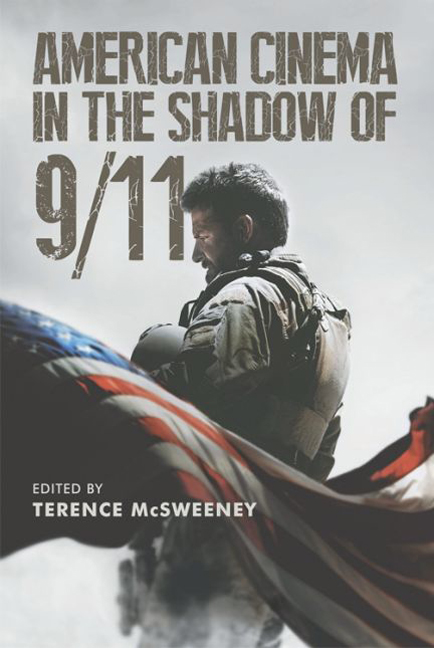Book contents
- Frontmatter
- Contents
- List of Figures
- Acknowledgements
- Foreword
- Introduction: American Cinema in the Shadow of 9/11
- Part I Dramatisations of the ‘War on Terror’
- 1 The Mythic Shape of American Sniper (2015)
- 2 Responding to Realities or Telling the Same Old Story? Mixing Real-world and Mythic Resonances in The Kingdom (2007) and Zero Dark Thirty (2012)
- 3 Acts of Redemption and ‘The Falling Man’ Photograph in Post-9/11 Us Cinema
- 4 ‘You be Very Mindful of How You Act’: Post-9/11 Culture and Arab American Subjectivities in Joseph Castelo' the War Within (2005) and Hesham Issawi' Americaneast (2008)
- 5 Refracting Fundamentalism in Mira Nair' the Reluctant Fundamentalist (2012)
- Part II Influences of the ‘War on Terror’
- Part III Allegories of the ‘War on Terror’
- Selected Filmography
- Notes on the Contributors
- Index
3 - Acts of Redemption and ‘The Falling Man’ Photograph in Post-9/11 Us Cinema
from Part I - Dramatisations of the ‘War on Terror’
Published online by Cambridge University Press: 10 May 2017
- Frontmatter
- Contents
- List of Figures
- Acknowledgements
- Foreword
- Introduction: American Cinema in the Shadow of 9/11
- Part I Dramatisations of the ‘War on Terror’
- 1 The Mythic Shape of American Sniper (2015)
- 2 Responding to Realities or Telling the Same Old Story? Mixing Real-world and Mythic Resonances in The Kingdom (2007) and Zero Dark Thirty (2012)
- 3 Acts of Redemption and ‘The Falling Man’ Photograph in Post-9/11 Us Cinema
- 4 ‘You be Very Mindful of How You Act’: Post-9/11 Culture and Arab American Subjectivities in Joseph Castelo' the War Within (2005) and Hesham Issawi' Americaneast (2008)
- 5 Refracting Fundamentalism in Mira Nair' the Reluctant Fundamentalist (2012)
- Part II Influences of the ‘War on Terror’
- Part III Allegories of the ‘War on Terror’
- Selected Filmography
- Notes on the Contributors
- Index
Summary
This article begins by providing context for the iconic photograph ‘The Falling Man’, which shows a single figure falling from the World Trade Center on 11 September 2001. It describes how the initial extremely restricted but varied experience of seeing people falling from the Twin Towers gave way to a single image: a photograph by veteran Associated Press photographer Robert Drew which has become known as ‘The Falling Man’. This photograph has been the subject of considerable debate, especially in relation to trauma, national identity and aesthetics. In what follows, this debate is used to describe how ‘The Falling Man’ photograph gives structure to two mainstream Hollywood films: Incredibly Loud and Extremely Close (Stephen Daldry, US, 2011) and The Walk (Robert Zemeckis, US, 2015). A particular focus will be how this photograph is placed to different ends within classically constructed narratives that seek some semblance of order and resolution and also made subject to the full animating resources of the moving image. This movement – from a photograph recording a fraction of a second to a conventional narrative of longer duration, and from still photograph to moving image – enables both films to seek different forms of redemption via what Thomas Stubblefield describes as ‘the cathartic power of the fall’ (Stubblefield 2015: 58).
An estimated two billion people worldwide watched news broadcasts showing the 11 September terrorist attacks (Friend 2007: 32–3). These news broadcasts contained a series of spectacular and shocking images – the planes flying into the buildings, the towers collapsing, lower Manhattan disappearing into an apocalyptic cloud of dust (Friend 2007: 32–3). Those who couldn't escape down the stairwells gathered around broken windows high in the towers, signalling for help and seeking to escape the heat and smoke. Many fell or chose to jump from the windows. According to a study conducted by USA Today, of the 2,948 people killed on 9/11 around two hundred, mainly located above the 90th floor in the North Tower, died in this way (Friend 2007: 133). Numerous amateur and professional photographers and videographers recorded their plight, including Jeff Christensen, Bill Biggart, Joseph McCarthy, Joe Scurto, Eddie Remy, Lyle Owerko and Richard Drew (Friend 2007: 29–31).
- Type
- Chapter
- Information
- American Cinema in the Shadow of 9/11 , pp. 67 - 88Publisher: Edinburgh University PressPrint publication year: 2017



